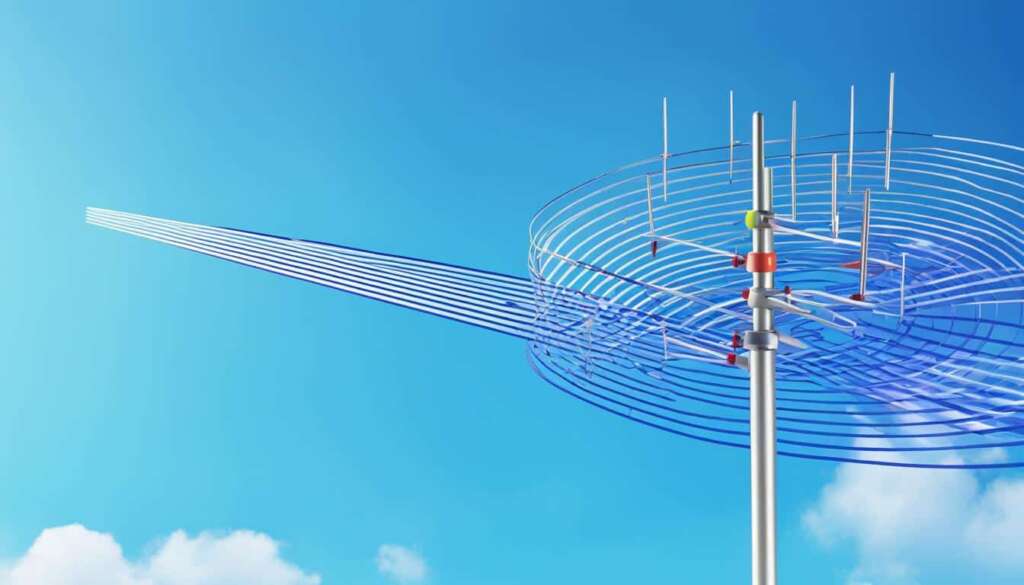Table of Contents
Welcome to our informative guide on antennas – the unsung heroes of modern communication. In this article, we will explore the functions, importance, and significance of antennas in enabling seamless wireless communication across various technologies and industries.
An antenna, in simple terms, is a specialized transducer that converts electric current into electromagnetic waves or vice versa. With the ability to transmit and receive nonionizing electromagnetic fields, such as radio waves, microwaves, infrared radiation, and visible light, antennas serve as vital components in establishing efficient communication networks.
Antennas are responsible for transmitting and receiving signals that power the devices we rely on every day, including mobile phones, routers, televisions, and satellite systems. Without antennas, these devices would be unable to send or receive information wirelessly, severely limiting their functionality and connectivity.
Through their unique properties and design, antennas facilitate the seamless transfer of data, voice, and video across vast distances. They enable the wireless communication technologies that have revolutionized our lives, connecting people and devices across the globe, from the hustle and bustle of urban environments to the most remote corners of the world.
As we dive deeper into this subject, we will explore how antennas work, their categorization, factors affecting their design and performance, and the critical concepts of impedance matching and antenna efficiency. Join us on this journey to uncover the fascinating world of antennas and their pivotal role in modern communication systems.
How Antennas Work and Their Categorization
Antennas are essential components in wireless communication systems, enabling the transmission and reception of electromagnetic waves. They can be classified into two broad categories: transmitting antennas and receiving antennas. Some antennas can perform both functions, allowing for bidirectional communication through a transceiver.
A transmitting antenna acts as an electromagnetic wave generator, converting electric current into electromagnetic waves. These waves carry information and propagate through the air or other mediums, such as cables or waveguides. They belong to the broader electromagnetic spectrum, encompassing radio waves, microwaves, infrared radiation, visible light, ultraviolet radiation, X-rays, and gamma rays.
On the other hand, a receiving antenna intercepts incoming electromagnetic waves and converts them back into electric current. This current is then utilized to extract the transmitted information. The efficiency and accuracy of a receiving antenna impact the overall performance of the communication system.
“The purpose of antennas is to facilitate the efficient transmission and reception of electromagnetic signals, supporting various communication technologies and applications.”
To further categorize antennas, they can be classified based on their physical characteristics, operating frequencies, directional properties, and applications. For example, antennas can be categorized as:
- Dipole antennas
- Monopole antennas
- Loop antennas
- Yagi-Uda antennas
- Parabolic antennas
- Microstrip antennas
- Helical antennas
Each antenna type possesses unique characteristics and advantages, making them suitable for specific applications. Understanding the different categories and selecting the appropriate antenna is crucial for optimizing the performance of wireless communication systems.
To illustrate the categorization of antennas, below is a table showcasing some common antenna types and their applications:
| Antenna Type | Applications |
|---|---|
| Dipole Antenna | Radio broadcasting, wireless communication systems |
| Monopole Antenna | Mobile phones, Wi-Fi routers |
| Loop Antenna | Inductive coupling, radio direction finding |
| Yagi-Uda Antenna | Television reception, long-distance communication |
| Parabolic Antenna | Satellite communication, radar systems |
| Microstrip Antenna | Wireless sensors, RF identification systems |
| Helical Antenna | Mobile satellite communication, GPS |
Factors Affecting Antenna Design and Performance
The size and design of an antenna play crucial roles in its performance and effectiveness. Several factors, such as resonance, wavelength, frequency, and tuning, need to be considered when designing an antenna to ensure optimal performance within specific frequency ranges.
The size of an antenna is directly related to the wavelength of the frequency it is designed to transmit or receive. As the wavelength increases, so does the physical size of the antenna. Conversely, lower frequencies require larger antennas, while higher frequencies can be accommodated with smaller antennas.
Furthermore, the length of the antenna also impacts its resonance frequency. The resonance frequency is the frequency at which the antenna operates most efficiently. To achieve the desired resonance, antennas need to be carefully designed and tuned. Improper design or tuning can result in reduced performance and effectiveness.
Tuning an antenna involves adjusting its components and dimensions to match the desired frequency range. This process ensures that the antenna efficiently transmits and receives signals within the specified frequency band. By properly tuning the antenna, designers can maximize its efficiency and effectiveness.
It is important to note that different antennas are required for different frequency ranges. Each antenna design is specifically tailored to work within a particular frequency range. High-frequency antennas, such as those used for satellite communication, have different requirements compared to antennas used for broadcasting or wireless communication.
Overall, the design, size, and tuning of an antenna are critical factors that affect its performance and ability to effectively transmit and receive signals. By considering these factors and using appropriate design techniques, engineers can develop antennas that meet the specific communication needs of various industries and technologies.

Stay tuned for the next section where we will explore the importance of impedance matching and antenna efficiency in maximizing power transfer.
Matching Impedance and Antenna Efficiency
When it comes to maximizing power transfer in antenna systems, impedance matching plays a crucial role. Impedance refers to the combined effect of resistance, inductance, and capacitance in an electrical circuit. In order to ensure efficient power transfer between the antenna, transmitter/receiver, and transmission line, the impedance of all components must be properly matched.
Different types of transmission lines are used depending on the distance and required impedance matching. For shorter distances, microstrip lines, which consist of a conducting strip on a dielectric substrate, are commonly used. These lines offer high impedance control and are ideal for compact systems.
On the other hand, coaxial cables are more suitable for longer distances. They consist of an inner conductor surrounded by an insulating layer, a conductive shield, and an outer insulating layer. Coaxial cables provide excellent signal integrity and are capable of handling high power levels, making them a reliable choice for efficient power transfer.
In addition to impedance matching, tuning the antenna is another important factor in maximizing its efficiency. By adjusting the antenna’s parameters, such as its length or element spacing, the antenna can be fine-tuned to resonate at the desired frequency. This tuning process ensures optimal performance and improves the antenna’s ability to transmit and receive signals effectively.
FAQ
What is the function of an antenna?
An antenna is a specialized transducer that converts electric current into electromagnetic waves or vice versa. It is used to transmit and receive nonionizing electromagnetic fields, such as radio waves, microwaves, infrared radiation, and visible light. Antennas play a crucial role in modern communication, allowing for the transmission and reception of signals that enable various technologies and industries to function.
How are antennas categorized?
Antennas can be categorized as either transmitting or receiving, and many antennas can perform both functions through a transceiver. A transmitting antenna generates electromagnetic waves from electric current, while a receiving antenna intercepts electromagnetic waves and converts them into a small amount of current.
What factors affect antenna design and performance?
The size of an antenna is determined by the wavelength of the frequency it is designed to transmit or receive. The length of the antenna affects its resonance frequency, making design and tuning important for optimal performance. Different antennas are required for different frequencies, as they are designed to work within specific frequency ranges.
Why is impedance matching important for antenna efficiency?
The impedance matching between the antenna, transmitter/receiver, and transmission line is essential for maximizing power transfer. Different types of transmission lines, such as microstrip lines and coaxial cables, are used based on the distance and required impedance matching.












